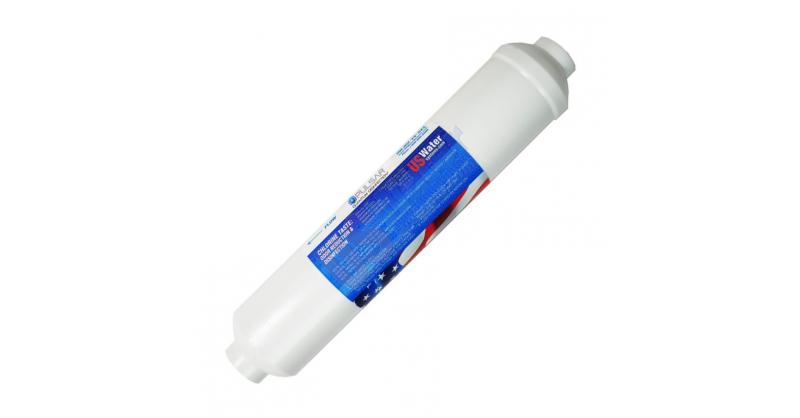Bacterial Removal
Reverse Osmosis membranes can remove bacteria from the water because they are designed to effectively remove dissolved ionic materials that are many orders of magnitude smaller than bacteria. The removal of bacteria cannot be guaranteed because there is no way of testing the unit short of challenging the membrane with bacteria. The other factor of importance is the large surface areas involved even in the small residential units (3-6 sq.ft.) means that there is probably at least one pin-hole or broken area that could allow at least one bacteria or spore to penetrate to the backside of the membrane. Because we are dealing with viable living organisms, it takes only one to start growth in a new location. Therefore, elements are designed to be operated on safe water supplies or provision made to disinfect the feed water prior to the R.O. system.
The general rule is the estimate bacteria removal at 3-log reduction (99.9% removal). The reduction can be substantially more but there is no way of proving it. Sterilizing filters used in the pharmaceutical industry are a type of microfiltration filter. A filter rated as 0.2 micrometer can remove all standard pathogenic bacteria. They are tested using one of the very smallest pseudomonas bacteria as a challenge organism. The results of challenge testing are then correlated to another non-destructive test known as bubble point. The test is to find the largest pore in the membrane. It is reasoned that if the largest pore is smaller than the smallest bacteria challenging the membrane, than there can be no bacteria penetration. The test looks at the pressure required to force fluid from the pore. The correlation of bubble point and pore size verses challenge results is basically empirical, but well accepted in the industry. The problem of applying the test to reverse osmosis is that the large amount of surface area has so much air diffusion that the bubble point is obscured beyond detection.
Microfiltration is for removing very small particles, ultrafiltration for removing dissolved molecular compounds, Nanofiltration for removing hardness, and reverse osmosis for removing most all dissolved salts. Each of the types of filtration deals with smaller and smaller size materials. R.O. is in a size range 1000 times smaller than the smallest bacteria, but the practical aspects of assembling elements means that there will be a chance that some damage to the surface will occur that will compromise the surface integrity, and therefore sterility. Elements are manufactured in a clean environment, but it is not sterile. Product side components can have exposure to mould and or bacteria from normal environmental conditions, so that even a spiral with no surface damage at all will have the potential of releasing something to the product side of the element. We go to great pains to minimize that potential, but there are no guarantees. The key is the system design and maintenance. In the cases where the unit is out of use for a long time mould and or bacteria sometimes grow; they should present only an esthetic compromise and not a serious health hazard if the unit is used correctly. Take assurance from the fact that R.O. has been used to produce millions of gallons of safe drinking water for over 25 years in the United States.
The general rule is the estimate bacteria removal at 3-log reduction (99.9% removal). The reduction can be substantially more but there is no way of proving it. Sterilizing filters used in the pharmaceutical industry are a type of microfiltration filter. A filter rated as 0.2 micrometer can remove all standard pathogenic bacteria. They are tested using one of the very smallest pseudomonas bacteria as a challenge organism. The results of challenge testing are then correlated to another non-destructive test known as bubble point. The test is to find the largest pore in the membrane. It is reasoned that if the largest pore is smaller than the smallest bacteria challenging the membrane, than there can be no bacteria penetration. The test looks at the pressure required to force fluid from the pore. The correlation of bubble point and pore size verses challenge results is basically empirical, but well accepted in the industry. The problem of applying the test to reverse osmosis is that the large amount of surface area has so much air diffusion that the bubble point is obscured beyond detection.
Microfiltration is for removing very small particles, ultrafiltration for removing dissolved molecular compounds, Nanofiltration for removing hardness, and reverse osmosis for removing most all dissolved salts. Each of the types of filtration deals with smaller and smaller size materials. R.O. is in a size range 1000 times smaller than the smallest bacteria, but the practical aspects of assembling elements means that there will be a chance that some damage to the surface will occur that will compromise the surface integrity, and therefore sterility. Elements are manufactured in a clean environment, but it is not sterile. Product side components can have exposure to mould and or bacteria from normal environmental conditions, so that even a spiral with no surface damage at all will have the potential of releasing something to the product side of the element. We go to great pains to minimize that potential, but there are no guarantees. The key is the system design and maintenance. In the cases where the unit is out of use for a long time mould and or bacteria sometimes grow; they should present only an esthetic compromise and not a serious health hazard if the unit is used correctly. Take assurance from the fact that R.O. has been used to produce millions of gallons of safe drinking water for over 25 years in the United States.
